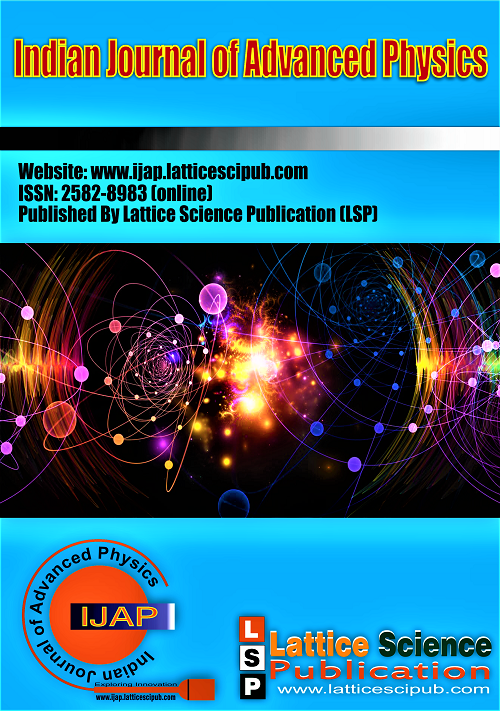Relative Nature of Electric Permittivity and Magnetic Permeability of Electromagnetic Wave
Main Article Content
Abstract
his research is about the special theory of relativity on electric permittivity and magnetic permeability of electromagnetic wave. For this, Four Maxwell’s electromagnetic equations play an important role. James Clerk Maxwell suggested that the light travel as electromagnetic wave which require no material medium for propagation. The speed of light (C) in free space is always constant and is independent of the speed of source or observer or the relative motion of the inertial system and has velocity ‘C’ given by. So velocity of electromagnetic waves depend on obsolute magnetic permeability (μ0) and obsolute electric permittivity (ε0) of free space. These two physical quantities rely on relative motion of inertial system. So μ0 and ε0 are not obsolute quantity but are dependent upon the relative motion between the observer and the phenomenon observed. Electric and magnetic field of a charge rely upon the value of obsolute electric permittivity of medium. Concisely, μ0 and ε0 are variant quantity. Consequently electric and magnetic field get relative for electromagnetic wave. That is electric and magnetic field depend on relative motion of inertial system for electromagnetic waves.
Downloads
Article Details

This work is licensed under a Creative Commons Attribution-NonCommercial-NoDerivatives 4.0 International License.
How to Cite
References
C.J. Smith, Radha, electricity and magnetism CBS publishers
Satya Prakash, electromagnetic theory and electrodynamics, Kedarnath and Ramnath and Co…, merut
Arora v.p. Sexena m.c. Prakash s- Electricity and magnetism: Pragati Prakashan, meerut
Laud B.B. – electromagnetic, Willy eastern Limited
K.K. Tiwari (2004), electricity and magnetism S. Chand and Co. Ltd.
Reitz J.R. milford F/J/ Christy R.W- Foundation of electromagnetic theory. Narosa Publishing House, New Delhi.
John R. Reitz, Robert W. Christy, Frederick J. Milford Foundation of electromagnetic theory, Narosa Publishing House.
Aruldhos, G…., Classical mechanics, New Delhi: PHI Learning Private Ltd., India
Binoy Bhattacharya, an introduction to classical mechanics, London: New Central book agency P. Ltd.
D.S. Mather, mechanics, New Delhi: S. Chand and Company Ltd. Ram Nagar
Elsevier, L.D. landau and E.M. Lifshiftz mechanics (Course of theoretical Physics, Moscow: ESSR academy of science.
Gupta, Kumar and Sharma, classical mechanics meerut pragati Prakashan, W.K. road
Halliday, Resnick and walker, fundamental of physics, willey India Pvt. Ltd.
Herbert, Goldstein Charles P. Poole, John SaFKO, classical mechanics, pearson education.
Musha (2019) superluminal speed of photons in the electromagnetic near-field
David J. Griffiths, Introduction to electrodynamics, Prentice-hall 1999, P 556
Feynman, R. (2006, 2010), The Feyman Lectures on Physics Vol. II Ch. 10. Dielectrics
Barrett, Terence. (1993). "Electromagnetic phenonmena not explained by Maxwell's equation Need Revision? A methodological Note".
Behero, Harihar & Barik N. (2018). "A New set of Maxwell-Lorentz equation and Rediscovery of Heaviside-maxwellian (vector) Gravity from Quantum field theory.
Maxwell J. (1861). "On physical lines of forces" The London. Edinburgh
Shaw, Dun can W, (2014) "Reconsidering Maxwell's aether" Physics essays, volume 27 Number 4, December 2014.
Jackson, John D. (1999). "Special theory of relativity". Classical electrodynamics.
Griffiths, David J. (2013). "Electrodynamics and Relativity". Introduction to electrodynamics
Onoochin, Vladimir (2019). "LONGITUDINAL ELECTRIC AND THE MAXWELL EQUATION".
Chaichain, m. Rojas, H.P., 8 Tureanu. A. (2021) Electromagnetism and Maxwell's Equations. In Basic concepts in physics (Pp. 101-135). Springer, Berlin, Heidelberg.
Ahmadivand, A, Gerislioglu, B., 8 Ramezani, Z. (2021). Classical
Electrodynamics in Toroidal Matamaterials (Pp. 7-39). Springer, cham.
Mitolo, M., 8 Araneo, R. (2019). A brief history of Maxwell's equation (History) IEEE Industry applications magazine
Fialova, S., 8 Pochyly, F. (2021). "A New Formulation of Maxwell' Equations."





